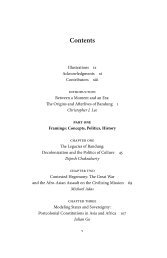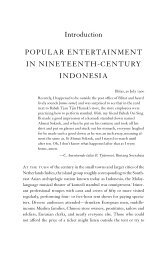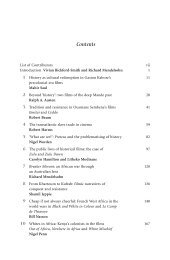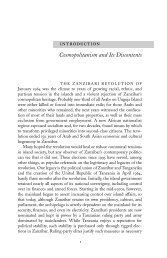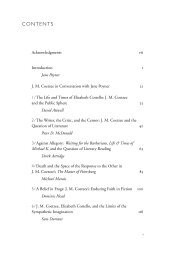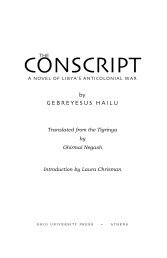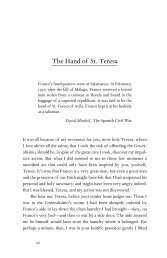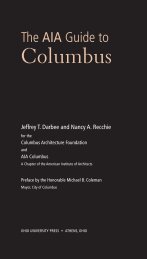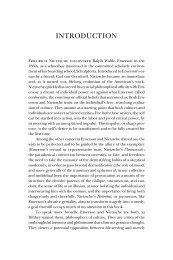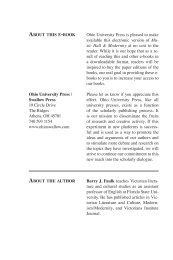Oscar Wilde and Modern Culture - Ohio University Press & Swallow ...
Oscar Wilde and Modern Culture - Ohio University Press & Swallow ...
Oscar Wilde and Modern Culture - Ohio University Press & Swallow ...
You also want an ePaper? Increase the reach of your titles
YUMPU automatically turns print PDFs into web optimized ePapers that Google loves.
even moderately profound things, <strong>and</strong> disposed to fribble <strong>and</strong> antic with old<br />
thoughts for lack of power to evolve new ones” (<strong>Oscar</strong> <strong>Wilde</strong> <strong>and</strong> Myself, 62–63).<br />
Douglas confused matters further in his 1929 Autobiography by stating that in<br />
1914 he did “not tell the whole truth” about his relations with <strong>Wilde</strong> (25); he thus<br />
began what amounts to a partial recantation in two further autobiographical<br />
works. In 1940, five years before his death, Douglas’s volte-face became complete<br />
when he went into print declaring that the “assurance that <strong>Wilde</strong> died a Catholic<br />
. . . enabled” Douglas “to undertake the task” of defending <strong>Wilde</strong>, since Douglas<br />
had been a convert to Rome since 1909. “When I speak of defending <strong>Wilde</strong>,”<br />
Douglas writes, “I do not mean defending his vices. . . . I mean defending his<br />
character apart from his vices.”₁⁰⁰ Even though in this later work Douglas disavows<br />
that he had any homosexual involvement with <strong>Wilde</strong>, he goes out of his<br />
way to claim that when reading the critical essays gathered in Intentions, “all the<br />
time one is conscious of an alert <strong>and</strong> well-informed intelligence which is not<br />
exploiting merely personal prejudices but is unobtrusively testifying to profound<br />
intellectual <strong>and</strong> artistic principles” (108). Underst<strong>and</strong>ably, the fact that Douglas<br />
engaged in tedious squabbles with other biographers has often discredited him<br />
as a reliable source in the study of <strong>Wilde</strong>.<br />
Yet Douglas, for all his tempestuousness, was more honest than the two (or,<br />
depending on how we count them, three) individuals who in the 1920s were<br />
responsible for committing serious frauds in <strong>Wilde</strong>’s legendary name. One of<br />
them, Arthur Cravan, happened to be a relative. Born Fabian Avenarius Lloyd,<br />
he was the second son of Constance <strong>Wilde</strong>’s brother, Otho Holl<strong>and</strong> Lloyd, <strong>and</strong><br />
he was raised in Switzerl<strong>and</strong>. Even though Cravan had no contact with <strong>Wilde</strong> (he<br />
was thirteen when his uncle by marriage died), he brought <strong>Wilde</strong>’s spirit alive in<br />
a posthumous interview published in his Surrealist magazine, Maintenant: Revue<br />
littéraire, in 1913.₁⁰₁ A performance artist, he delivered lectures, which involved<br />
bizarre displays of dancing <strong>and</strong> boxing. By all accounts, he cut an imposing figure;<br />
Blaise Cendrars recalled the amazing spectacle of Cravan doing the tango at a<br />
Paris nightclub “in a black shirt with the front cut away to reveal ‘bleeding tattoos<br />
<strong>and</strong> obscene inscriptions on his skin.’”₁⁰² After traveling to New York in 1917,<br />
Cravan fell in love with <strong>and</strong> subsequently married American poet Mina Loy.<br />
They moved to Mexico City, where he became a competition boxer, <strong>and</strong> in 1918<br />
he set sail to meet his spouse, who awaited him in Buenos Aires. It appears that<br />
he was lost at sea; at least, Loy, who recalled her marriage as the happiest period<br />
of her life, thought so.<br />
Introduction 31



